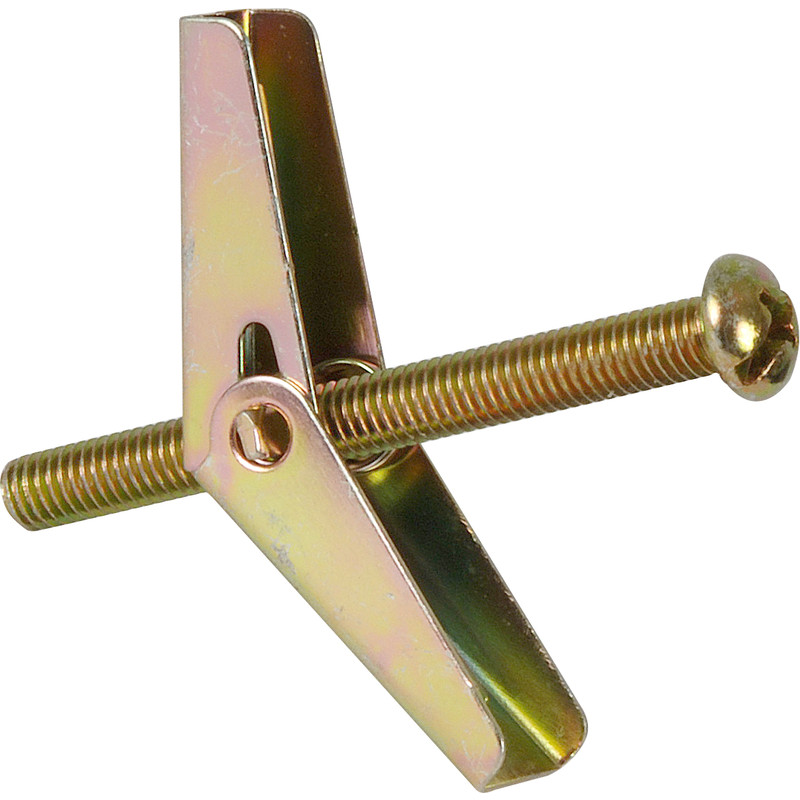- Joined
- 25 Aug 2016
- Messages
- 3
- Reaction score
- 0
- Country

Hi everyone,
I'm currently attempting to install a couple of Ikea 'LACK' floating shelves, but am having difficulty with the screw fixings (metal anchors) not sitting securely in the wall, and could do with a bit of advice.
The shelves are intended to be fixed to the wall by securing a bracket to the wall with screws, with the shelf then slotting onto metal tubes projecting from the bracket.
The wall I have chosen is a dividing wall between two adjoining houses (i'd guess 1960s built, in London, UK). It's clearly a solid wall, from the feel and sound when tapping it, however I'm not sure what the specific structure is. - it's covered in quite thick wallpaper, and seems to have a fair depth of plaster before encountering brickwork.
I bought some metal anchor screws (see images linked below), which I planned to secure the bracket into.
having drilled a small (4mm) pilot hole, I screwed in the anchor screws, and despite going in flush to the wallpaper, they never get even slightly tight and are both able to spin in the hole, as well as being easily pulled straight out.
it appears that what I'm screwing into is very soft plaster, which is just being torn apart by the screws. Drilling the holes was pretty easy most of the way, but I definitely hit brickwork at the back.
I'd be very grateful for some advice on:
- are these the most appropriate fittings for this application?
- if not, what should I use to attach something to this wall?
- do I need to use something longer, and go deeper into the brickwork? (I'm not sure how easy this will be with the drill I have, which is not a hammer drill / ideal for proper masonry work)
I don't have a great deal of experience with this sort of thing, but I think the problem is the amount of 'soft' material in front of the solid wall - the red-ish plaster seems to be very crumbly and loose.
the opposite wall is clearly hollow (although I haven't drilled it yet, and am not sure of its exact composition either) - might it be easier to fit these to that wall? - it's not my preference, but if it's infinitely easier I'd consider it.
If i need to give up on the current wall, any advice on filling and finishing it to get rid of the holes I've created is also very welcome!
The link below includes a few pictures of the screws, the wall and the hole they have created, which hopefully will help someone to work out what the composition of the wall is!
http://imgur.com/a/spwaV
Many thanks for any advice.
Paul.
I'm currently attempting to install a couple of Ikea 'LACK' floating shelves, but am having difficulty with the screw fixings (metal anchors) not sitting securely in the wall, and could do with a bit of advice.
The shelves are intended to be fixed to the wall by securing a bracket to the wall with screws, with the shelf then slotting onto metal tubes projecting from the bracket.
The wall I have chosen is a dividing wall between two adjoining houses (i'd guess 1960s built, in London, UK). It's clearly a solid wall, from the feel and sound when tapping it, however I'm not sure what the specific structure is. - it's covered in quite thick wallpaper, and seems to have a fair depth of plaster before encountering brickwork.
I bought some metal anchor screws (see images linked below), which I planned to secure the bracket into.
having drilled a small (4mm) pilot hole, I screwed in the anchor screws, and despite going in flush to the wallpaper, they never get even slightly tight and are both able to spin in the hole, as well as being easily pulled straight out.
it appears that what I'm screwing into is very soft plaster, which is just being torn apart by the screws. Drilling the holes was pretty easy most of the way, but I definitely hit brickwork at the back.
I'd be very grateful for some advice on:
- are these the most appropriate fittings for this application?
- if not, what should I use to attach something to this wall?
- do I need to use something longer, and go deeper into the brickwork? (I'm not sure how easy this will be with the drill I have, which is not a hammer drill / ideal for proper masonry work)
I don't have a great deal of experience with this sort of thing, but I think the problem is the amount of 'soft' material in front of the solid wall - the red-ish plaster seems to be very crumbly and loose.
the opposite wall is clearly hollow (although I haven't drilled it yet, and am not sure of its exact composition either) - might it be easier to fit these to that wall? - it's not my preference, but if it's infinitely easier I'd consider it.
If i need to give up on the current wall, any advice on filling and finishing it to get rid of the holes I've created is also very welcome!
The link below includes a few pictures of the screws, the wall and the hole they have created, which hopefully will help someone to work out what the composition of the wall is!
http://imgur.com/a/spwaV
Many thanks for any advice.
Paul.

